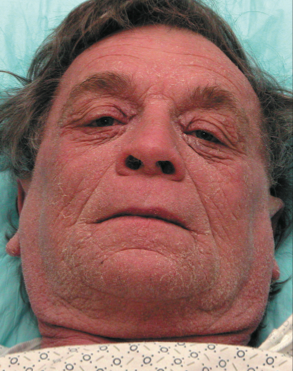A 56-year-old man with diffuse erythema

THE CASE: A 56-year-old man presents with diffuse erythema. He has not changed his routine or eaten anything unusual. The rash initially appeared the previous night as asymptomatic erythema on the face and body. On awakening in the morning, the patient noticed that the erythema had spread over most of his body and had become pruritic. Over-the-counter diphenhydramine did not relieve the symptoms.
The patient has asthma, for which he uses albuterol as needed. He has no known allergies. He is a smoker and drinks alcohol occasionally; he denies exposure to other drugs or potential irritants. There is no family history of similar rashes, and the patient states that normally his skin is clear.
Examination reveals that the erythema covers the patient's entire body. Several annular papules are noted on the anterior aspect of the thighs and knees. Diffuse scaly eczematous lesions are present on the face and the dorsal aspect of the feet.
On further questioning, the patient recalls that he has had this type of rash twice before in the past 20 years. His condition was extensively worked up both times, but no definitive diagnosis was made.

What is the likely cause of the rash?
- Cutaneous drug eruption
- Psoriasis
- Contact dermatitis
- Atopic dermatitis

DISCUSSION: The patient has exfoliative dermatitis (erythroderma), a disorder in which more than 90% of the cutaneous surface is scaling, erythematous, and inflamed. Annular papules may appear as well. The rash often obscures primary lesions that may help explain the evolution of the disease. Up to 30 g of exfoliated scale is lost per day. This frequently results in hypoalbuminemia. Edema and pruritus are common findings. Scaling usually starts 2 to 6 days after the onset of the erythema.
In about 30% of cases of exfoliative dermatitis, no cause is found. Drug allergy is thought to be the culprit in about 28% of cases; lymphoma and leukemia in 14%; atopic dermatitis in 10%; psoriasis in 8%; contact dermatitis in 3%; and seborrheic dermatitis in 2%.
A detailed history is crucial to help determine the cause of the outbreak. Treatment depends on the cause and symptoms. Systemic corticosteroids and antihistamines are prescribed initially. Topical corticosteroids, avoidance of scratching, and application of moisturizers will relieve symptoms. Have the patient discontinue all unnecessary medications and new environmental exposures and remove all suspected provocative agents.
This patient's laboratory results revealed eosinophilia, mild thrombocytopenia, and hypoalbuminemia; a biopsy and pathology report showed abundant eosinophils. These findings pointed to a hypersensitivity reaction, most likely to albuterol.
Cutaneous drug eruptionsare associated with many medications and can mimic a variety of skin disorders. Consider drug eruption in any patient who has been taking medication or who has started a new medication. Drug eruptions can present with such symptoms as pruritus, lip swelling, blisters, photophobia, and anaphylaxis.Although the history is important, the critical component of treatment is removal of the offending agent. Treatment consists of antihistamines, topical and oral corticosteroids, and moisturizing lotions or creams.
Psoriasis features well-defined dark red plaques with distinctive silvery scales. Removal of the scale reveals minute bleeding points (Auspitz sign). Psoriasis usually presents symmetrically and is found primarily on the knees, elbows, sacral area, and scalp. Erythrodermic psoriasis is an exfoliative reaction in which the entire surface of the skin becomes red, warm, and scaly. Diagnosis is based on the location and appearance of the lesions. Pathology studies usually reveal a thickened epidermis (acanthosis) and a thinned or absent granular cell layer.Maintenance of core body temperature is impaired as a result of massive exfoliation. Dehydration, hypoalbuminemia, and anemia of chronic disease are common sequelae. Sunburn, infection, and various medications may precipitate and/or exacerbate these sequelae.
Contact dermatitis is caused by a chemical irritant or an allergic reaction. The allergic type is attributable to a delayed hypersensitivity reaction in the skin. Patients first become sensitized to an antigen with one or many exposures. Following reexposure, a pruritic lesion develops within 12 to 48 hours. Among the most common allergens are nickel, chromium, neomycin, and oleoresin (poison oak, poison ivy, and poison sumac). Treatment consists of removal of the offending agent and application of cool compresses and topical glucocorticoids. Systemic glucocorticoids may be needed for severe reactions.
Patients with atopic dermatitis usually have a family history of asthma or rhinitis. They often have a decreased itching threshold and dry skin. Pruritic rashes are common in these patients; the rashes typically occur on the head and neck and are initially red, swollen, and raised.
Atopic dermatitis in infants most commonly involves the extensor surfaces; in older patients, the flexural surfaces are affected. The lesions tend to scab and become weepy from scratching. Treatment involves hydration, water-trapping agents, and moderate-strength topical glucocorticoids.


